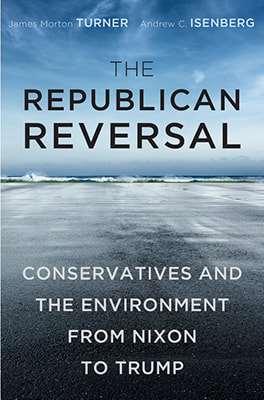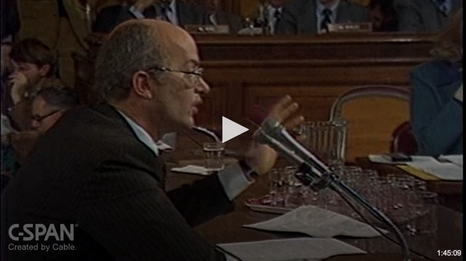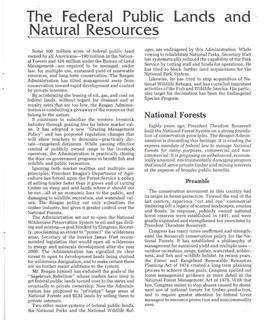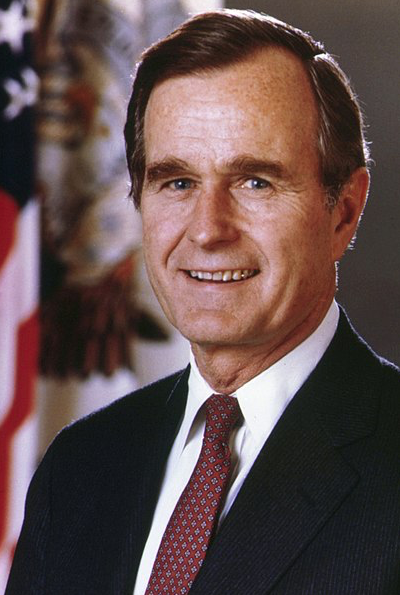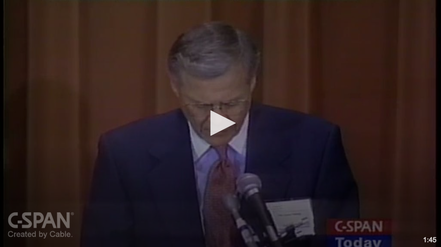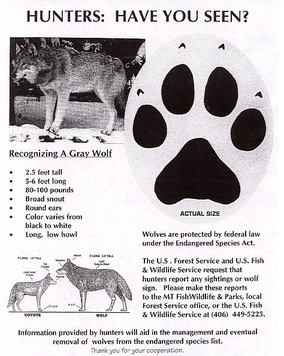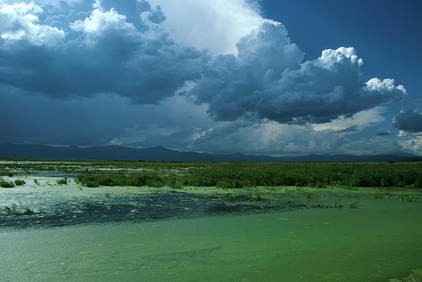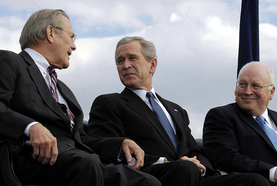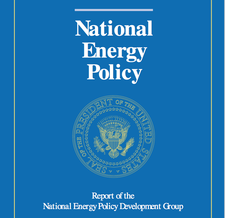CHAPTER TWO:
Visions of Abundance
|
Primary Sources
|
|
1981
“WE ARE ALSO CONCERNED ABOUT MR. WATT’S CONNECTIONS TO THE VERY RESOURCE DEVELOPMENT INTERESTS HE WILL BE REQUIRED TO REGULATE” - KIMBALL 1982
1992
“YET AMERICANS TODAY REALIZE THAT WE CAN PROTECT OUR LANDS WHILE ALSO USING THEM FOR THE PEOPLE’S BENEFIT” - BUSH 1994
1995Robert Smith, Competitive Enterprises Institute, on Endangered Species Act | PDF
In 1994, a government report found that 90 percent of the species listed and protected under the ESA depended on habitats on private property. Many conservative think-tanks published reports supporting private ownership, including one by Robert Smith at the Competitive Enterprises Institute. Smith argued that public land use causes “overuse, waste, and extinction,” while private ownership promotes “sustained-yield use and preservation.“ 1996
2001
“FEDERAL AUTHORITIES WERE FORCED TO CUT OFF WATER TO 1,500 FARMS... BECAUSE OF THE ‘ENDANGERED’ SUCKERFISH” - STRASSEL
2017
|
|
Discussion Questions
- Why did Reagan’s message resonate so powerfully in the West during the 1980 election?
- How did Republicans and environmentalists view the public lands in the West in the early 1980’s?
- What was the Sagebrush Rebellion? Why did it gain strength in the late 1970’s?
- To what extent did Watt’s approach to natural resources and energy production consolidate a new approach to resource management in the United States?
- What is the significance of the Powder River Basin? How did the coal leasing act lead to government subsidized coal on the market?
- Describe how the Reagan and Nixon administrations had different approaches to environmental reforms and protections (based on Chapters 1 & 2).
- Why did Republicans gain strong support from the rural West in the 1994 midterm elections?
- What made Clinton’s use of the Antiquities Act to protect national monuments so controversial in the mid-1990’s?
- Explain why the Endangered Species Act and the spotted owl case a became a lighting rod for controversy during the late 1980’s and early 1990’s.
- How did Richard Pombo proposal to reform the Endangered Species Act to ease the burden on private land holders? Why did his proposals fail?
- In what ways did the beliefs of evangelical Christians both contribute to and pose challenges for advancing environmental reform?
- Why do the authors call the Republican Party the ”modern [party] of extraction?” To what extent might that label be applied to the Democratic Party?
Additional Readings
Public Lands
"Strip Mining Control Bill Signed"
CQ Almanac | Washington, D.C.: Congressional Quarterly, 1978
The Other Rights Revolution: Conservative Lawyers and the Remaking of American Government
Jefferson Decker | New York: Oxford University Press, 2016
Public Lands and Political Meaning: Ranchers, the Government, and the Property Between Them
Karen R. Merrill | Berkeley: University of California Press, 2002
“Summary of Information Concerning the Ecological and Economic Impacts of the Deepwater Horizon Oil Spill Disaster”
National Resources Defense Council |NRDC issue paper, June 2015
The Promise of Wilderness: American Environmental Politics since 1964
James Morton Turner | Seattle: University of Washington, 2012
“The Specter of Environmentalism”: Wilderness, American Politics, and the Evolution of the New Right
James Morton Turner | Journal of American History, June 2009 | Website with teaching and research materials
The Bet: Paul Ehrlich, Julian Simon, and Our Gamble over Earth’s Future
Paul Sabin | New Haven, CT: Yale, 2013 | Additional sources on Sabin’s website
CQ Almanac | Washington, D.C.: Congressional Quarterly, 1978
The Other Rights Revolution: Conservative Lawyers and the Remaking of American Government
Jefferson Decker | New York: Oxford University Press, 2016
Public Lands and Political Meaning: Ranchers, the Government, and the Property Between Them
Karen R. Merrill | Berkeley: University of California Press, 2002
“Summary of Information Concerning the Ecological and Economic Impacts of the Deepwater Horizon Oil Spill Disaster”
National Resources Defense Council |NRDC issue paper, June 2015
The Promise of Wilderness: American Environmental Politics since 1964
James Morton Turner | Seattle: University of Washington, 2012
“The Specter of Environmentalism”: Wilderness, American Politics, and the Evolution of the New Right
James Morton Turner | Journal of American History, June 2009 | Website with teaching and research materials
The Bet: Paul Ehrlich, Julian Simon, and Our Gamble over Earth’s Future
Paul Sabin | New Haven, CT: Yale, 2013 | Additional sources on Sabin’s website
The Powder River Basin and Federal Coal Policy
Analysis of the Powder River Basin Federal Coal Lease Sale: Economic Valuation Improvements and Legislative Changes Needed
Comptroller General | Report to Congress, Washington, DC: Government Accountability Office, 1983
“The Great Giveaway: An Analysis of the Costly Failure of Federal Coal Leasing in the Powder River Basin”
Tom Sanzillo | Institute for Energy Economics and Financial Analysis, June 2012
“America’s Incoherent Coal Policy”
James Surowiecki |The New Yorker, 7 December 2015
“The Making of Federal Coal Policy: Lessons for Public Lands Management from a Failed Program, an Essay and Review”
A. Dan Tarlock |Natural Resources Journal, 1985
“Federal Coal Leasing in the Powder River Basin: A Bad Deal for Taxpayers”
Nidhi Thakar and Michael Madowitz | Center for American Progress, 29 July 2014
Comptroller General | Report to Congress, Washington, DC: Government Accountability Office, 1983
“The Great Giveaway: An Analysis of the Costly Failure of Federal Coal Leasing in the Powder River Basin”
Tom Sanzillo | Institute for Energy Economics and Financial Analysis, June 2012
“America’s Incoherent Coal Policy”
James Surowiecki |The New Yorker, 7 December 2015
“The Making of Federal Coal Policy: Lessons for Public Lands Management from a Failed Program, an Essay and Review”
A. Dan Tarlock |Natural Resources Journal, 1985
“Federal Coal Leasing in the Powder River Basin: A Bad Deal for Taxpayers”
Nidhi Thakar and Michael Madowitz | Center for American Progress, 29 July 2014
Endangered Species Act
Beyond the Grizzly: Endangered Species and the Politics of Place in California
Pete Alagona | Berkeley: University of California Press, 2013
“The Endangered Species Act at Thirty”
Dale Goble, J. Michael Scott, and Frank W. Davis | Renewing the Conservation Promise, Washington, DC: Island Press, 2006
Acting for Endangered Species: The Statutory Ark
Shannon Petersen | Lawrence: University Press of Kansas, 2002
Pete Alagona | Berkeley: University of California Press, 2013
“The Endangered Species Act at Thirty”
Dale Goble, J. Michael Scott, and Frank W. Davis | Renewing the Conservation Promise, Washington, DC: Island Press, 2006
Acting for Endangered Species: The Statutory Ark
Shannon Petersen | Lawrence: University Press of Kansas, 2002
Other
“Unintentional Gerrymandering: Political Geography and Electoral Bias in Legislatures”
Jowei Chen |Quarterly Journal of Political Science, 27 June 2013
“How Rural Resentment Helps Explain the Surprising Victory of Donald Trump”
Katherine Cramer | The Washington Post, 13, November 2016
American Environmental Policy: Beyond Gridlock
Christopher McGrory Klyza and David J. Sousa | Cambridge, MA: MIT Press, 2013
The Republican War on Science
Chris Mooney | New York: Basic Books, 2005
Jowei Chen |Quarterly Journal of Political Science, 27 June 2013
“How Rural Resentment Helps Explain the Surprising Victory of Donald Trump”
Katherine Cramer | The Washington Post, 13, November 2016
American Environmental Policy: Beyond Gridlock
Christopher McGrory Klyza and David J. Sousa | Cambridge, MA: MIT Press, 2013
The Republican War on Science
Chris Mooney | New York: Basic Books, 2005

